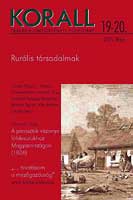A Zala megyei parasztság helyzete a 18. században az úrbérrendezés forrásainak tükrében
The situation of the peasantry of Zala County in the 18th century in the light of the sources of the socage-settlement
Author(s): Zita HorváthSubject(s): History
Published by: KORALL Társadalomtörténeti Egyesület
Keywords: Hungary; social history;19th century; county Zala; social stratification; peasants; economy; social status
Summary/Abstract: My paper examines the peasant society of Zala County through the sources generated during the socage-settlement, especially peasants’ testimonies and the socage register. Fortunately the sources analyzed have been relatively well preserved in the Zala County Archives; in place of the missing ones I used the material of the Departmentum Urbariale of the Archives of the Governor-General’s Council in the Hungarian National Archives. In the 18th century, Zala County consisted of six districts, many villages, 23 market towns, and ha no free royal towns. Among its landowners we find such large holders as the Esterházy-family, whose ducal line owned over 80 settlements (the Alsólendva, Csobánc, and Lenti estate), and a number of villages in the county belonged to the earldom’s Pápa-Ugod-Devecser estate. At the time of the socage-settlement, the Muraköz estate formerly owned by the Zrínyi-family belonged to the Count Althann-family, and the Count Csáky-family and the Batthyányis also had significant estates (the Belatinc estate and the Kanizsa-Homokkomárom and Szentgrót estates). Beside these, there were some well-off medium holders, many smallholders with a few plots, and an abundance of lesser and peasant nobilitywith partial plots. The dues of the serfswere as diverse as the estate structure of the county. Priory to the socage-settlement more than half of the serfs were villeins free to move, only the lesser part were permanent bondmen. Prior to Maria Theresa’s unified urbary, the system of dues were governed by custom, urbary or contract. According to the prevalent view among the authorities on the subject, the position of serfs paying dues on the basis of a contract was the most favorable, as they paid a cash tenure in lieu of a part or the entirety of their dues. Taxation on the basis of contractswas very widespread in Zala County, too, which consisted of either cash only, or (rarely) labor rent, or,most often, of villeinage and cash. At the same time the rate and composition of custom-based taxation was also very similar. Communities only very rarely had urbaries prior to the socage-settlement. Contractualists were always free to move, while among those paying taxes according to custom, there were both villains with free movement and permanent bondmen. In general we may say that the status of the freedom of movement also implied more favorable taxation, but the status of permanent bondmen was not necessarily worse, i.e. the dues born by the serfs in a given community did not automatically correlate with their status. The geographical location, natural resources, the person of the landlord and, probably, the customs going back for decades or centuries were more important in the determination of the dues to be provided by the serfs. The authorities almost always regard the socage-settlement as positive, and, taken in its entirety, it probably did hold more advantages than drawbacks. Nevertheless, it has to be said that the sources generated during t
Journal: Korall - Társadalomtörténeti folyóirat
- Issue Year: 2005
- Issue No: 19-20
- Page Range: 132-159
- Page Count: 28
- Language: Hungarian

